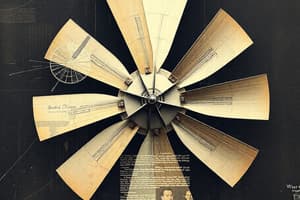Podcast
Questions and Answers
What characteristic of asymmetrical rotor blades contributes to greater lift for the same surface area?
What characteristic of asymmetrical rotor blades contributes to greater lift for the same surface area?
- Straight edges
- Symmetrical design
- Uniform chord length
- Higher camber on one side (correct)
Which rotor blade design is most commonly used due to its stable aerodynamic characteristics?
Which rotor blade design is most commonly used due to its stable aerodynamic characteristics?
- Negative Twist
- Asymmetrical
- Symmetrical (correct)
- Tapered
Which material is NOT used to make rotor blades?
Which material is NOT used to make rotor blades?
- Composite
- Wood
- Metal
- Plastic (correct)
Which planform design is characterized by leading and trailing edges running parallel to each other?
Which planform design is characterized by leading and trailing edges running parallel to each other?
What is a primary inspection method for composite rotor blades?
What is a primary inspection method for composite rotor blades?
Why do manufacturers prefer uniform blades over tapered blades?
Why do manufacturers prefer uniform blades over tapered blades?
What effect does adding weight to the leading edge of a rotor blade have?
What effect does adding weight to the leading edge of a rotor blade have?
What is a primary advantage of bonded construction for rotor blades?
What is a primary advantage of bonded construction for rotor blades?
What happens when weight is added to the front of a rotor blade?
What happens when weight is added to the front of a rotor blade?
Where are trim tabs generally located on a rotor blade?
Where are trim tabs generally located on a rotor blade?
What is required for static discharge capabilities in rotor blades?
What is required for static discharge capabilities in rotor blades?
What should always be rigged first on a helicopter?
What should always be rigged first on a helicopter?
What is the purpose of the main servo flap on a rotor blade?
What is the purpose of the main servo flap on a rotor blade?
What is the purpose of painting the bottom of rotor blades matte black?
What is the purpose of painting the bottom of rotor blades matte black?
Why is the servo flap located at about 75 percent span of the rotor blade?
Why is the servo flap located at about 75 percent span of the rotor blade?
What is a characteristic of blades designed with servo flaps?
What is a characteristic of blades designed with servo flaps?
Flashcards
Tap Testing
Tap Testing
A method used to inspect composite rotor blades by tapping on the surface to identify any damage or defects like delamination or cracking.
Double Plates
Double Plates
These plates add structural strength to the rotor blade's root without adding extra weight. They are found near the base of the blade.
Spanwise Balance Weights
Spanwise Balance Weights
Weights added to the blade tip, at the center of the spanline to balance the rotor blade's rotation.
Chordwise Mass Balance Weight
Chordwise Mass Balance Weight
Signup and view all the flashcards
Tracking Weights
Tracking Weights
Signup and view all the flashcards
Trim Tabs
Trim Tabs
Signup and view all the flashcards
Servo Flap
Servo Flap
Signup and view all the flashcards
Autorotational Check
Autorotational Check
Signup and view all the flashcards
Symmetrical Rotor Blades
Symmetrical Rotor Blades
Signup and view all the flashcards
Asymmetrical Rotor Blades
Asymmetrical Rotor Blades
Signup and view all the flashcards
Uniform Planform Blades
Uniform Planform Blades
Signup and view all the flashcards
Tapered Planform Blades
Tapered Planform Blades
Signup and view all the flashcards
Negative Twist Blades
Negative Twist Blades
Signup and view all the flashcards
Bonded Rotor Blade Construction
Bonded Rotor Blade Construction
Signup and view all the flashcards
Single Pocket Rotor Blade Construction
Single Pocket Rotor Blade Construction
Signup and view all the flashcards
Multi Pocket Rotor Blade Construction
Multi Pocket Rotor Blade Construction
Signup and view all the flashcards
Study Notes
Rotor Blade Designs
- Symmetrical blades have a better aerodynamic pitch characteristic.
- Asymmetrical blades produce more lift for the same surface area; they have more camber on one side. Engineered asymmetric blades can achieve the same advantages as symmetrical blades through blade edge sweeping.
- Symmetrical blades are more common due to the instability of asymmetrical design.
- Two main blade planform types: parallel (uniform) and tapered.
- Uniform planforms have parallel leading and trailing edges and create more lift due to the consistent chord length.
- Tapered planforms have converging leading and trailing edges, decreasing chord length, causing more uniform lift across the blade.
- Manufacturers prefer uniform blades because of cost-effectiveness; only one rib part number is needed.
- Tapered blades require different rib numbers due to varying chord length.
- Tapered blade designs provide more equal lift across the blade by featuring negative twist, allowing for higher angles of attack at the root (where rotation is slower) to ensure the same lift across the entire blade span.
Rotor Blade Construction
- Bonded construction is preferred for strength and avoids drilling holes in the blade.
- Single-pocket construction is quicker to build but is more difficult to repair if damage occurs; multi-pocket construction allows easier repair.
Rotor Blade Balance and Trim
- Balance weights are added to specified locations on the blade for proper balance and flight characteristics.
- Weights added to the blade's leading edge make the helicopter fly lower, while adding weight to the trailing edge makes it fly higher.
- Trim tabs provide an easier way to adjust the blade's pitch than balance weights and rely on airflow velocity.
- Adjusting trim tabs higher will lower the flight of the helicopter, and vice versa.
- Hydraulics need to be turned off during rigging to remove residual pressure before connecting the collective and throttle controls together.
- The collective and throttle are connected via correlator or auto-throttle linkage.
- Rigging of collective is done initially, and then throttle is correctly connected.
- Helicopter is tested with ground runs, hovers, and full flight tests, finishing with an autorotation check at minimum gross weight.
Rotor Blade Features
- Erosion protection capping (stainless steel) is used for the leading edges of rotor blades.
- Rotor blades are painted matte black to reduce glare for the pilot.
- Composite materials for blades offers static discharge abilities, and are inspected via a tap test.
- Additional double plates are implemented at the root and tip for increased structural strength, without increasing blade weight.
Studying That Suits You
Use AI to generate personalized quizzes and flashcards to suit your learning preferences.




